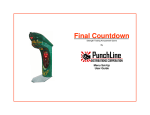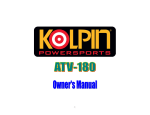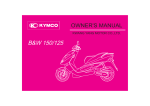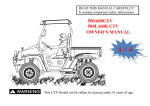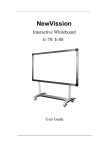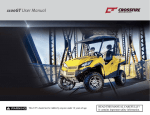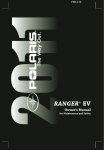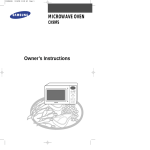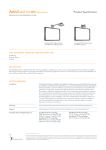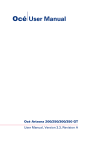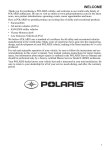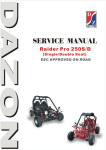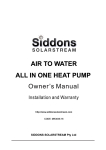Download 200GT User Manual - Crossfire Motorcycles
Transcript
READ THIS MANUAL CAREFULLY! It contains important safety information. 150UTV/150UTV-2 200UTV/200UTV-2 OWNER’S MANUAL OWNER’S MANUAL 200GT 4×2 This UTV should not be ridden by anyone under 12 years of age without direct adult supervision. INTRODUCTION Congratulations on your purchase of the 150/200UTV. With the purchase of this UTV, you can now appreciate the high degree of craftsmanship. This manual will provide you with a good basic understanding of the features and operation of this UTV. This manual includes important safety information. It provides information about special techniques and skills necessary to ride your UTV. It also includes basic maintenance and inspection procedures. If you have any questions regarding the operation or maintenance of your UTV, please consult you dealer. AN IMPORTANT SAFETY MESSAGE: ● READ THIS MANUAL FOR THE UTV RIDER CAREFULLY AND COMPLETELY BEFORE OPERATING YOUR UTV. MAKE SURE YOU UNDERSTAND ALL INSTRUCTIONS. ● PAY CLOSE ATTENTION TO THE WARNING AND CAUTION LABELS ON THE UTV. ● NEVER OPERATE A UTV WITHOUT PROPER TRAINING OR INSTRUCTION. FREE TRAINING IS AVAILABLE TO ANYONE WHO BUYS A NEW UTV. ● THIS UTV, AND ANY OTHER UTV OVER 90cc, SHOULD NOT BE RIDDEN BY ANYONE UNDER 12 YEARS OF AGE. INFORMATION FAILURE TO FOLLOW THE WARNINGS CONTAINED IN THIS MANUAL CAN RESULT IN SERIOUS INJURY OR DEATH. Particularly important information is distinguished in this manual by the following notations: The Safety Alert Symbol means ATTENTION! BECOME ALERT! Failure to follow WARNING instructions could result in severe injury or death to the machine operator, a bystander or a person inspecting or repairing the machine. A CAUTION indicates special precautions that must be taken to avoid damage to the machine. NOTE: A NOTE provides key information to make procedures easier or clearer. IMPORTANT NOTICE This UTV is designed and manufactured for OFF-ROAD use only. It is illegal and unsafe to operate this UTV on any public street, road or highway. This UTV complies with all applicable OFF-ROAD noise level and spark arrester laws and regulations in effect at the time of manufacture. Please check your local riding laws and regulations before operating this UTV. TABLE OF CONTENTS Introduction…………………………………………………………………………………1 SAFETY………………………………………………………………………………………3 Features and Controls……………………………………………………………………21 Component Locations………………………………………………………………………21 Indicator and switch………………………………………………………………23 Seats…………………………………………………………………………………………24 Driver’s seat adjustment…………………………………………………………………24 Seat Belts……………………………………………………………………………………24 Seat Belt Inspection………………………………………………………………………25 Fuel cap …………………………………………………………………………………25 Ignition Switch ……………………………………………………………………………26 Gear Selector………………………………………………………………………………27 Parking Brake………………………………………………………………………………27 Brake Pedal…………………………………………………………………………………28 Throttle Pedal………………………………………………………………………………28 OPERATION………………………………………………………………………………29 Vehicle break-in period……………………………………………………………………30 Pre-ride inspection…………………………………………………………………………31 Safe operation practices……………………………………………………………………32 Starting the engine…………………………………………………………………………33 Stopping the engine…………………………………………………………………………34 Braking……………………………………………………………………………………34 Parking the vehicle…………………………………………………………………………34 New operator driving procedures…………………………………………………………35 Driving with a passenger…………………………………………………………………37 Driving on slippery surface………………………………………………………………38 Driving uphill………………………………………………………………………………40 Driving on a sidehill………………………………………………………………………41 Driving downhill……………………………………………………………………………41 Driving through water……………………………………………………………………42 Driving over obstacles……………………………………………………………………43 Driving in reverse…………………………………………………………………………44 Parking on an incline………………………………………………………………………45 MAINTENANCE…………………………………………………………………………46 Periodic maintenance chart …………………………………………………………47 Engine oil …………………………………………………………………………………49 Spark plugs…………………………………………………………………………………53 Filter system ………………………………………………………………………………54 Throttle system ……………………………………………………………………………56 Carburetor …………………………………………………………………………………58 Brakes………………………………………………………………………………………59 Steering wheel inspection …………………………………………………………………61 Shock spring adjustment …………………………………………………………………61 Tires…………………………………………………………………………………………62 Drive chain lubrication……………………………………………………………………63 Drive chain slack……………………………………………………………………………63 Drive chain slack adjustment……………………………………………………………64 WARRANTY………………………………………………………………………65 SPECIFICATIONS………………………………………………………………………68 Ci rcu it D i a g r a m … … … …… …… … … …… … … …… … ………… ………… …7 1 INTRODUCTION Failure to follow the warnings and safety precautions contained in this manual can result in severe injury or death. Your vehicle is not a toy and can be hazardous to operate. This vehicle handles differently than cars, trucks or other off-road vehicles. A collision or rollover can occur quickly, even during routine maneuvers like turning, or driving on hills or over obstacles, if you fail to take proper precautions. ● Read this owner’s manual. Understand all safety warnings, precautions and operating procedures before driving the vehicle. Keep this manual with the vehicle. ● Never operate this vehicle without proper instruction. ● Always follow the age guidelines for your vehicle. Operation is prohibited for anyone age 12 and under. Never operate with a passenger age 12 and under. 1 INTRODUCTION Identification number records Record the vehicle identification number and engine number in the spaces provided for assistance when ordering spare parts from your dealer or for reference in case the vehicle is stolen. NOTE:The vehicle identification number is used to identify your machine. 2 SAFETY Equipment Modifications Your vehicle is designed to provide safe operation when used as directed. Modifications to your vehicle may negatively impact vehicle stability. Failure of critical machine components may result from operation with any modifications, especially those that increase speed or power. This vehicle may become less stable at speeds higher than those for which it is designed. Loss of control may occur at higher speeds. Do not install on a vehicle any equipment that may increase the speed or power of the vehicle, or make any other modifications to the vehicle for these purposes. Any modifications to the original equipment of the vehicle create a substantial safety hazard and increase the risk of bodily injury. The warranty on your vehicle is terminated if any equipment has been added to the vehicle, or if any modifications have been made to the vehicle, that increases its speed or power. The addition of certain accessories may change the handling characteristics of the vehicle. Use only our company approved accessories, and familiarizes yourself with their function and effect on the vehicle. 3 SAFETY Safe Riding Gear Always wear appropriate clothing when riding this vehicle. Wear protective clothing for comfort and to reduce the chance of injury. 4 SAFETY Safe Riding Gear Helmet Wearing a helmet can prevent a severe head injury. Whenever riding this vehicle, always wear a helmet that meets or exceeds established safety standards. Approved helmets in the USA and Canada bear a U.S. Department of Transportation (DOT) label. Eye Protection Do not depend on eyeglasses or sunglasses for eye protection. Whenever riding a vehicle, always wear shatterproof goggles or use a shatterproof helmet face shield. Gloves Wear gloves for comfort and for protection from sun, cold weather and other elements. Boots Wear sturdy footwear. Do not ride a vehicle with bare feet. Clothing Wear long sleeves and long pants to protect arms and legs. 5 SAFETY Safety Warnings Failure to operate this vehicle properly can result in a collision, loss of control, accident or overturn, which may result in serious injury or death. Be sure to read all of the following warnings about driving hazards and how to avoid them. These warnings are provided for your safety. Operating Without Instruction Operating this vehicle without proper instruction increases the risk of an accident. The operator must understand how to operate the vehicle properly in different situations and on different types of terrain. Age Restrictions Operation is prohibited for anyone age 12 and under. Never operate with a passenger age 12 and under. Make sure any passenger is tall enough to comfortably and safely reach the hand holds and place both feet on the floor. 6 6 SAFETY Safety Warnings Failure to Inspect Before Operating Failure to inspect and verify that the vehicle is in safe operating condition before operating increases the risk of an accident. Always inspect the vehicle before each use to make sure it's in safe operating condition. Always follow the inspection and maintenance procedures and schedules described in the owner's manual. Accessories Installing non-approved accessories may seriously affect vehicle handling and stability, which could result in loss of control or an accident. Never install accessories not approved by our company for use on this vehicle. 7 SAFETY Safety Warnings Protective Apparel Riding in this vehicle without wearing an approved helmet and protective eyewear increases the risk of serious injury in the event of an accident. Operator and passenger must always wear an approved helmet that fits properly and eye protection (goggles or face shield). Seat Belts Riding in this vehicle without wearing the seat belt increases the risk of serious injury in the event of an accident or sudden stop. Riders must wear seat belts at all times. Seat belts reduce the severity of injury in the event of a sudden stop or accident. Always make sure the seat belts are secured for both the operator and passenger before riding. Using Alcohol or Drugs Riding in this vehicle after consuming alcohol or drugs could adversely affect operator judgment, reaction time, balance and perception. Never consume alcohol or drugs before or while operating or riding in this vehicle. 8 SAFETY Safety Warnings Carrying a Passenger Never carry a passenger until you have operated this vehicle for at least four hours. Carrying Multiple Passengers Carry more than limitative passengers of the labels of the 150/200UTV can affect the operator’s ability to steer and operate the controls, which increases the risk of loss of control and accident or overturn. Never carry more than limitative passenger in this vehicle. Operating on Pavement Operating this vehicle on paved surfaces (including sidewalks, paths, Parking lots and driveways) may seriously affect handling and control of the vehicle, and may cause the vehicle to go out of control. This vehicle's tires are designed for off-road use only, not for use on pavement. Avoid operating the vehicle on pavement. If you must operate on a paved surface, travel slowly and do not make sudden turns or stops. Operating on Public Roads Operating this vehicle on public streets, roads or highways could result in a collision with another vehicle. Never operate this vehicle on any public street, road or highway, including dirt and gravel roads. In many areas it's unlawful to operate vehicles of this type on public streets, roads and highways. 9 SAFETY Safety Warnings Operating at Excessive Speeds Operating this vehicle at excessive speeds increases the operator's risk of losing control. Always operate at a speed that's appropriate for the terrain, the visibility and operating conditions, your skills and your passenger’s skills. Turning Improperly Turning improperly could cause loss of traction, loss of control, accident or overturn. Never turn abruptly or at sharp angles. Never turn at high speeds. Practice turning at slow speeds before attempting to turn at faster speeds. Physical Control of the Vehicle Removing hands from the steering wheel or hand holds or removing feet from the floor while riding increases the risk of loss of control and accident or overturn. The operator should always keep both hands on the steering wheel during operation. A passenger should always be seated in the passenger seat with both feet on the floor and with both hands securely grasping the hand holds. Always keep hands and feet inside the vehicle at all times. 10 SAFETY Safety Warnings Jumps and Stunts Exhibition driving increases the risk of an accident or overturn. DO NOT do power slides, “donuts”, jumps or other driving stunts. Avoid exhibition driving. Driving Downhill Improperly Driving down a hill improperly could cause loss of control or overturn. Always follow proper procedures for driving down a hill as described in the owner's manual. ● Always drive down a hill with the transmission in forward gear. Never drive down a hill with the transmission in neutral. ● Never operate the vehicle on hills steeper than 15 degrees. ● Always check the terrain carefully before driving down a hill ● Never travel down a hill at high speed. ● Avoid traveling down a hill at an angle, which would cause the vehicle to lean sharply to one side. Travel straight downhill. 11 SAFETY Safety Warnings Improper Hill Climbing Improper hill climbing could cause loss of control or overturn. Use extreme caution when operating on hills. Always follow proper procedures for hill climbing as described in the owner's manual. Stalling While Climbing a Hill Stalling or rolling backwards while climbing a hill could cause an overturn. Maintain a steady speed when climbing a hill. If you lose all forward speed: Apply the brakes gradually until the vehicle is fully stopped. Place the transmission in reverse and slowly allow the vehicle to roll straight downhill while applying light brake pressure to control speed. Crossing Hillsides Driving on a sidehill is not recommended. Improper procedure could cause loss of control or overturn. Avoid crossing the side of any hill unless absolutely necessary. 12 SAFETY Safety Warnings Operating in Unfamiliar Terrain Failure to use extra caution when operating on unfamiliar terrain could result in an accident or overturn. Unfamiliar terrain may contain hidden rocks, bumps, or holes that could cause loss of control or overturn. Travel slowly and use extra caution when operating on unfamiliar terrain. Always be alert to changing terrain conditions. Operating on Sand or Slippery Terrain Operating on sand or on excessively rough, slippery or loose terrain could cause loss of traction, loss of control, accident or overturn. Always use extra caution when operating on sand or on rough, slippery or loose terrain. Do not operate on excessively rough, slippery or loose terrain. 13 SAFETY Safety Warnings Operating Improperly in Reverse Improperly operating in reverse could result in a collision with an obstacle or person. Always follow proper operating procedures as outlined in this manual. Before shifting into reverse gear, always check for obstacles or people behind the vehicle. When it's safe to proceed, back slowly. Operating Over Obstacles Improperly operating over obstacles could cause loss of control or overturn. Before operating in a new area, check for obstacles. Never attempt to operate over large obstacles such as rocks or fallen trees. Always follow the proper procedures outlined in this manual when operating over obstacles. Skidding or Sliding Skidding or sliding can cause loss of control or overturn (if tires regain traction unexpectedly). Always follow proper procedures for operating on slippery surfaces as described in the owner's manual. When operating on slippery surfaces such as ice or loose gravel, reduce speed and use extra caution to reduce the chance of skidding or sliding. Do not operate on excessively slippery surfaces. 14 SAFETY Safety Warnings Operating Through Water Operating through deep or fast-flowing water can cause loss of traction, loss of control, overturn or accident. Never operate in fast-flowing water or in water that exceeds the floor level. Always follow proper procedures for operating in water as described in the owner's manual. Wet brakes may have reduced stopping ability. After leaving water, test the brakes. Apply them lightly several times while driving slowly. The friction will help dry out the pads. Overloading the Vehicle Overloading the vehicle may cause changes in stability and handling, which could cause loss of control or an accident. ● Never exceed the maximum weight capacity for this vehicle. 15 SAFETY Safety Warnings Operating a Damaged Vehicle Operating a damaged vehicle can result in an accident with serious injury or death. After any overturn or accident, have a qualified service dealer inspect the entire vehicle for possible damage, including (but not limited to) brakes, throttle and steering systems. Operating on Frozen Bodies of Water Operating on frozen bodies of water can result in the vehicle and/or riders falling through the ice. Never operate this vehicle on a frozen body of water. 16 SAFETY Safety Warnings Handling Gasoline Gasoline is highly flammable and is explosive under certain conditions. Always exercise extreme caution whenever handling gasoline. ● Never allow a child to refuel or handle gasoline. ● Always stop the engine when refueling. ● Always refuel outdoors or in a well ventilated area. ● Do not smoke or allow open flames or sparks in or near the refueling area or where gasoline is stored. ● Never refuel while a person is in the vehicle. ● Do not over fill the tank. Do not fill the tank neck. ● If gasoline spills on your skin or clothing, immediately wash it off with soap and water and change clothing. ● Turn the fuel valve off whenever the vehicle is stored or parked. Exposure to Exhaust Engine exhaust fumes are poisonous and can cause loss of consciousness or death in a short time. Never start the engine or let it run in an enclosed area. Operate this vehicle only outdoors or in well-ventilated areas. 17 SAFETY Safety Warnings Hot Exhaust Systems Exhaust system components are very hot during and after use of the vehicle. Hot components can cause burns and fire. Do not touches hot exhaust system components. Always keep combustible materials away from the exhaust system. Use caution when traveling through tall grass, especially dry grass. Always inspect the underside of the vehicle and areas near the exhaust system after driving through tall grass, weeds, brush and other tall ground cover. Promptly remove any grass or debris clinging to the vehicle. Unauthorized Use of the Vehicle Leaving the keys in the ignition can lead to unauthorized use of the vehicle, which could result in an accident or overturn. Always remove the ignition key when the vehicle is not in use. Safety Labels and Locations Warning labels have been placed on the vehicle for your protection. Read and follow the instructions on each label carefully. If any of the labels shown in this manual differ from the labels on your vehicle, always read and follow the instructions of the labels on the vehicle. If an informational or graphic label becomes illegible or comes off, contact your dealer to purchase a replacement. 18 SAFETY Safety Labels and Locations Warning Label WARNING Improper vehicle use can result in SEVERE INJURY or DEATH NEVER allow vehicle to be operated: ● Without all occupants first viewing and understanding safety warning labels. ● With more than stipulate passenger. ● On hills steeper than 15 degrees. ● On paved surfaces - pavement may seriously affect handling and control. ● With non-approved accessories, they may seriously affect stability. ● At speeds that are too fast for the operator’s skills, the conditions and/or the terrain. ALWAYS require operator and passenger to: ● Wear seat belts, grab hand holds (passenger) and plant feet firmly on the floor. ● Keep hands and feet inside vehicle. ● Avoid quick turns of the steering wheel and driving stunts such as jumps, donuts or power slides. ● Reduce speed and use extra caution when carrying a passenger. ● Watch for branches or other hazards that could enter vehicle. 19 SAFETY Safety Labels and Locations Warning Label WARNING Operation of this vehicle by children age 12 and under increases the risk of severe injury or death. NEVER permit children age 12 and under to operate or ride in this vehicle. WARNING VEHICLE OVERTURN could cause severe injury or death. The cab frame is not designed or intended to provide rollover protection. TIRE PRESSURE IN PSI (KPa): Front: 5±0.2(33.5±1.5) Rear: 7±0.2(47±1.5) LOADING CAPACITY:220 lbs. (100Kg) INCLUDES WEIGHT OF OPERATOR, PASSENGER AND ACCESSORIES. LOCATE AND READ OWNER’S MANUAL. FOLLOW ALL INSTRUCTIONS AND WARNINGS. IF OWNER’S MANUAL IS MISSING, CONTACT YOUR DEALER FOR A REPLACEMENT. 20 FEATURES AND CONTROLS Component Locations 21 FEATURES AND CONTROLS Component Locations 22 FEATURES AND CONTROLS Indicator and switch 1、Speed indicator 2、Shift indicator 3、Turning indicators 4、High beam indicator 5、Odometer 6、Low beam/high beam switch 7、Light switch 8、Turning switch 9、Horn switch 23 10、Alarm light switch 11、Ignition switch FEATURES AND CONTROLS Seats Driver’s Seat Adjustment 1. Lift the seat latch lever 1 located under the right front edge of the driver’s seat. 2. While holding the lever upward, slide the seat forward or rearward to the desired position, then release the lever. 3. Slide the seat forward and rearward to ensure the latch is engaged. Before operating the vehicle, always make sure both seats are securely installed. Seat Belts This vehicle is equipped with three-point lap seat belts for the operator and passenger. Always make sure the seat belts are secured for both the operator and passenger before riding. To wear the seat belt properly, follow this procedure: 1. Pull the seat belt latch downward and across your chest toward the buckle at the inneredge of the seat. The belt should fit snugly across your hips and diagonally across your chest. Make sure the belt is not twisted. 2. Push the latch plate into the buckle until it clicks. 3. Press the red release latch on the buckle to release the seat belt. 24 FEATURES AND CONTROLS Seat Belt Inspection Inspect all seat belts for proper operation before each use of the vehicle. 1. Push the latch plate into the buckle until it clicks. The latch plate must slide smoothly into the buckle. A click indicates that it's securely latched. 2. Push the red release latch in the middle of the buckle to make sure it releases freely. 3. Inspect the full length for any damage, including cuts, wear, fraying or stiffness. If any damage is found, or if the seat belt does not operate properly, have the seat belt system checked and/or replaced by an authorized dealer. 4. To clean dirt or debris from the seat belts, sponge the straps with mild soap and water. Do not use bleach, dye or household detergents. Fuel Cap Never allow a child to refuel or handle gasoline. The fuel tank filler cap is located on the behind of the rear cargo box of the vehicle. Open the fuel tank port cover, you can see the fuel tank cap. When refueling, always use unleaded gasoline. 25 FEATURES AND CONTROLS Ignition Switch Ignition switch has four positions: “OFF”(close)position:All circuits are turnoff except emergency light, electric fan and cigarette lighter. “ACC” position: lights, horn, windshield wiper “ON”(open)position:All circuits except engine are connected, and they could start at any moment or make engine keep running status. “ST”(start)position:Connect engine and ignition circuit, and start engine. Handle returns to “ON” position automatically after engine starts. 26 FEATURES AND CONTROLS Gear Selector F: Forward N: Neutral R: Reverse The gear selector is located between the seats. To change gears, stop the vehicle, and with the engine idling, move the lever to the desired gear. Do not attempt to shift gears with engine speed above idle or while the vehicle is moving. Tip: Maintaining shift linkage adjustment is important to assure proper transmission function. See your dealer if you experience any shifting problems. NOTICE: Do not attempt to shift the transmission while the vehicle is moving or damage to the transmission could result. Always shift when the vehicle is stationary and the engine is at idle. Parking Brake 1. Apply the brakes. 2. When the vehicle is fully stopped, pull the parking brake lever rearward as far as possible to set the parking brake. 3. Stop the engine. 4. To release the parking brake, apply the brakes and push the lever toward the passenger seat and forward. 27 FEATURES AND CONTROLS Tip: Always set the parking brake whenever the vehicle is left unattended. Operating the vehicle while the parking brake is engaged could cause an accident resulting in serious injury or death. It could also result in driveline or engine damage. Always be sure to disengage the parking brake before operating the vehicle. Brake Pedal Depress the brake pedal to slow or stop the vehicle. Apply the brakes while starting the engine. Throttle Pedal Push the pedal down to increase engine speed. Spring pressure returns the pedal to the rest position when released. Always check that the throttle pedal returns normally before starting the engine. Make sure there's adequate throttle pedal freeplay. See page 43 for throttle pedal adjustment procedures. If the throttle cable should stick in an open position when the operator releases the throttle pedal, the engine will stop and power to the rear wheels will cease. 28 OPERATION Failure to operate the vehicle properly can result in a collision, loss of control, accident or overturn, which may result in serious injury or death. Read and understand all safety warnings outlined in the safety section of this owner’s manual. Vehicle Break-in Period The break-in period for your new vehicle is defined as the first ten hours of operation, or the time it takes to use the first two full tanks of gasoline. No single action on your part is as important as a proper break-in period. Careful treatment of a new engine and drive components will result in more efficient performance and longer life for these components. Perform the following procedures carefully. NOTICE: Excessive heat build-up during the first three hours of operation will damage close-fitted engine parts and drive components. Do not operate at full throttle or high speeds during the first three hours of use. Mixing brands or using a non-recommended oil may cause serious engine damage. Always use the recommended oil. Never substitute or mix oil brands. 29 OPERATION Vehicle Break-in Period Engine and Drivetrain Break-in 1. Fill the fuel tank with gasoline. Always exercise extreme caution whenever handling gasoline. Never allow a child to handle gasoline. 2. Check the oil level. See page 50. Add the recommended oil as needed to maintain the oil level in the safe operating range. 3. Complete the New Operator Driving Procedures outlined on pages35-36. 4. Avoid aggressive use of the brakes. See Brake System Break-in below. 5. Vary throttle positions. Do not operate at sustained idle. 6. Perform regular checks on fluid levels, controls and areas outlined on the daily pre-ride inspection checklist. See page31. 7. Change the engine oil at 10 hours or one month. 8. Adjust and lubricate the drive chain at 10 hours or one month. Brake System Break-in Apply only moderate braking force for the first 50 stops. Aggressive or overly forceful braking when the brake system is new could damage brake pads and rotors. 30 OPERATION Pre-Ride Inspection Failure to inspect and verify that the vehicle is in safe operating condition before operating increases the risk of an accident. Always inspect the vehicle before each use to make sure it's in safe operating condition. Item Remarks Page Brake system/pedal travel Ensure proper operation 59 Steering Engine oil Air filter Ensure free operation Ensure proper levels Inspect, clean 61 49 50 51 52 54 55 Seat Belts 24 25 Brake fluid Check length of belt for damage, check latches for proper operation Ensure proper level Tires Inspect condition 62 Throttle system Ensure proper operation 56 Ensure proper operation -- Inspect condition 53 Indicator lights/switches Spark plug 31 60 57 OPERATION Safe Operation Practices 1. Complete the New Operator Driving Procedures outlined on pages 35-36. 2. Do not ride at night or when visibility is poor (rain, fog, dusk). Your vehicle doesn't have lights that are designed for driving in these conditions. 3. Engine exhaust fumes are poisonous. Never start the engine or let it run in an enclosed area. Never allow a child to handle gasoline. 4. Never install accessories not approved by our company for use on this vehicle. 5. Never operate the vehicle on pavement or on any public street, road or highway, including dirt and gravel roads. 6. Drive in a manner appropriate for your skills and operating conditions. Never operate at excessive speeds. DO NOT attempt to do power slides, “donuts”, jumps or other driving stunts. Keep both hands on the steering wheel at all times. 7. Never consume alcohol or drugs before or while operating this vehicle. 8.Always use the size and type of tires specified for your vehicle. Always maintain proper tire pressure. 9.Never operate a damaged vehicle. After any overturn or accident, have a qualified service dealer inspect the entire machine for possible damage. 10. Never operate the vehicle on a frozen body of water. 11. Do not touch hot exhaust system components. Always keep combustible materials away from the exhaust system. 12. Always remove the ignition key when the vehicle is not in use to prevent unauthorized use. 32 OPERATION Starting the Engine 1. Sit in the driver's seat and fasten the seat belt. 2. Place the transmission in neutral. Set the parking brake. 3. Apply the brakes. 4. Do not press the throttle pedal while starting the engine. 5. Turn the ignition key to the “ST” position. Engage the starter for a maximum of five seconds. Release the key when the engine starts. NOTICE: Operating the vehicle immediately after starting could cause engine damage. Allow the engine to warm up for several minutes before operating the vehicle. 6. If the engine does not start within five seconds, return the ignition switch to the “ON” position and wait five seconds. Repeat steps 5 and 6 until the engine starts. Tip: If a warm engine has cooled to a point where it does not readily start, intermittent use of the choke (pulled half way out) may be necessary. If the engine is over-choked when warm, depress the throttle lever fully while cranking to aid in starting. Release the throttle lever immediately after the engine starts. If the engine does not start and all conditions are favorable, change the spark plug and try again. 7. Vary the engine RPM slightly with the throttle to aid in warm-up until the engine idles smoothly. 8. Release the parking brake before driving. 33 OPERATION Stopping the Engine 1. Release the throttle pedal completely and brake to a complete stop. 2. Place the transmission in neutral. 3. Set the parking brake. 4. Stop the engine. Braking 1. Release the throttle pedal completely. (When the throttle pedal is released completely and engine speed slows to near idle, the vehicle has no engine braking.) 2. Press on the brake pedal evenly and firmly. Practice starting and stopping (using the brakes) until you're familiar with the controls. Parking the Vehicle 1. Stop the vehicle on a level surface. When parking inside a garage or other structure, be sure that the structure is well ventilated and that the vehicle is not close to any source of flame or sparks, including any appliance with pilot lights. 2. Place the transmission in neutral. 3. Set the parking brake. 4. Stop the engine. 5. Remove the ignition key to prevent unauthorized use. 34 OPERATION New Operator Driving Procedures 1. Read and understand the owner's manual and all warning and instruction labels before operating this vehicle. 2. Review the section of this owner’s manual about starting the engine, stopping the engine, braking and parking (pages33-34). 3. Perform the pre-ride inspection 4. Wear appropriate riding gear, including an approved helmet and eye protection (goggles or face shield). 5. Select a level open area to practice driving. 6. Sit in the driver's seat and fasten the seat belt. 7. Do not carry a passenger until you have at least four hours of driving experience with this vehicle. 8. Set the parking brake. 9. Place the transmission in neutral. 10. Start the engine. 11. Apply the brakes and shift into gear. 12. Release the parking brake. 35 OPERATION 13. Check your surroundings. Make sure the area is clear of people and obstacles. 14. Keeping both hands on the steering wheel, slowly release the brakes and press the throttle with your right foot to begin driving. 15. Drive slowly at first. Practice starting, stopping, turning, using the throttle and brakes and driving in reverse. Learn how the vehicle handles when making both left and right turns at a slow speed. 16. Increase speed only after mastering all maneuvers at a slow speed. 17. After you become skilled at making turns and begin to operate at faster speeds, follow these precautions: ● Avoid sharp turns. Make turns gradually. ● Never turn while applying heavy throttle. ● Never turn the steering wheel abruptly. ● Operate at speeds appropriate for your skills, the conditions and the terrain. ● Do not attempt to do power slides, “donuts”, jumps or other driving stunts. 36 OPERATION Driving with a Passenger 1. Complete the New Operator Driving Procedures outlined on Pages 35-36. 2. Perform the pre-ride inspection. 3. Do not carry a passenger until you have at least four hours of driving experience with this vehicle. 4. Never operate with a passenger age 12 and under. Make sure the passenger is tall enough to comfortably and safely sit in the passenger seat with the seat belt secured, put both feet on the floor and grasp the hand holds. 5. Never carry more than limitative passengers of the labels of the 150/200UTV . 6. Never allow a passenger to ride on the cargo box. Allow passenger to ride only in the passenger seat. 37 OPERATION 7. Make sure the passenger is wearing appropriate riding gear, including an approved helmet and eye protection. See page 4. 8. Make sure the passenger secures the seat belt. 9. Tell your passenger to always keep hands and feet inside the vehicle at all times. 10. Drive slowly. Vehicle handling may change with a passenger on board. Always travel at a speed appropriate for your skills, your passenger's skills, and operating conditions. Avoid unexpected or aggressive maneuvers that could cause discomfort or injury to a passenger. 11. Always follow all operating guidelines as outlined on safety labels and in this manual. Driving on Slippery Surfaces When driving on slippery surfaces such as wet trails, loose gravel, sand or ice, be alert for the possibility of skidding and sliding. Skidding or sliding can cause loss of control or overturn, especially if tires regain traction unexpectedly. When operating on slippery surfaces such as ice or loose gravel, slow down and use extra caution to help prevent skidding or sliding. Always use extra caution when operating on sand or on rough, slippery or loose terrain. Do not operate on excessively rough, slippery or loose terrain. 38 OPERATION Follow these precautions when driving in slippery conditions: 1. Slow down before entering slippery areas. 2. Be alert, watch the path ahead and avoid quick turns, which can cause skids. 3. Correct a skid by turning the steering wheel in the direction of the skid. Never apply the brakes during a skid. 39 OPERATION Driving Uphill Whenever traveling uphill, follow these precautions: 1. Always check the terrain carefully before ascending a hill. 2. Avoid steep hills (15° maximum). 3. Drive straight uphill. 4. Never climb hills with excessively slippery or loose surfaces. 5. Drive at a steady rate of speed. Never press the throttle suddenly. 6. Avoid unnecessary changes in speed or direction. 7. Never go over the crest of a hill at a high speed. An obstacle, a sharp drop, or another vehicle or person could be on the other side of the hill. 8. If the vehicle stalls while climbing a hill, apply the brakes. Place the transmission in reverse and slowly allow the vehicle to roll straight downhill while applying the brakes lightly to control speed. 40 OPERATION Driving on a Sidehill (Sidehilling) Driving on a sidehill is not recommended. Driving on a sidehill improperly cause loss of control or overturn. If crossing a hill is unavoidable, follow these precautions: 1. Drive slowly and use extreme caution. 2. If the vehicle begins to overturn, or if it feels as if it may overturn, immediately turn downhill. 3. Avoid obstacles and changes in terrain that may lower or raise one side of the vehicle or cause the vehicle to slide. 4. If the vehicle begins to slide downhill, immediately turn downhill to stop the slide. Driving Downhill Whenever driving down a hill, follow these precautions: 1. Avoid steep hills (15° maximum). 2. Slow down. Never travel down a hill at high speed. 3. Always check the terrain carefully before driving down a hill. 4. Always drive down a hill with the transmission in forward gear. Never “coast” or drive down a hill with the transmission in neutral. 5. Avoid driving down a hill at an angle, which would cause the vehicle to lean sharply to one side. Always drive straight downhill. 6. Apply the brakes lightly to keep speed slow. 41 OPERATION Driving Through Water Your vehicle can drive through shallow water. Make sure the water is no deeper than the floor of the vehicle. Follow these precautions when driving through water: 1. Check water depth. Never drive through water that is deeper than the floor level. 2. After driving through water, test the brakes. Apply them lightly several times while driving slowly. The friction will help dry out the pads. NOTICE: Major engine damage can result if the vehicle is not thoroughly inspected after operation in water. Perform the services outlined in the maintenance chart. Give special attention to engine oil, transmission oil and all grease fittings. If your vehicle is operated in water deeper than the floor level, take it to your dealer for service before starting the engine. If it's impossible to bring the vehicle to your dealer before starting the engine, perform the service outlined, and take the vehicle to your dealer as soon as possible. 42 OPERATION Driving Over Obstacles Follow these precautions when driving over obstacles: 1. Always check for obstacles before driving in a new area. 2. Look ahead and watch the terrain. Always be alert for hazards such as logs, rocks and low hanging branches. 3. Drive slowly and use extra caution when driving on unfamiliar terrain. Obstacles are not always clearly visible. 4. Do not drive over large obstacles such as rocks and fallen trees. If it’s unavoidable, use extreme caution and drive slowly. 5. Always have a passenger dismount and move away from the vehicle before driving over an obstacle that could cause an overturn. 43 OPERATION Driving in Reverse Follow these precautions when driving in reverse: 1. Always check for obstacles or people behind the vehicle. 2. Apply the throttle lightly. Never apply the throttle suddenly. 3. Back slowly. 4. Apply the brakes lightly for stopping. 5. Avoid making sharp 44 OPERATION Parking on an Incline A rolling vehicle can result in serious injury. Avoid parking on an incline. If parking on an incline is unavoidable, follow these precautions: 1. Place the transmission in neutral. 2. Set the parking brake. 3. Stop the engine. 4. Turn the fuel valve off. 5. Always block the rear wheels on the downhill side. 45 MAINTENANCE Periodic Maintenance Chart Careful periodic maintenance will help keep your vehicle in the safest, most reliable condition. Inspection, adjustment and lubrication of important components are explained in the periodic maintenance chart. Inspect, clean, lubricate, adjust and replace parts as necessary. When inspection reveals the need for replacement parts, use genuine parts available from your dealer. Service and adjustments are important for proper vehicle operation. If you're not familiar with safe service and adjustment procedures, have a qualified dealer perform these operations. Maintenance intervals in the following chart are based upon average riding conditions and an average vehicle speed of approximately ten (10) miles per hour. Vehicles subjected to severe use must be inspected and serviced more frequently. Severe Use Definition ● Frequent immersion in mud, water or sand ● Racing or race-style high RPM use ● Prolonged low speed operation ● Extended idle ● Short trip cold weather operation Pay special attention to the oil level. A rise in oil level during cold weather can indicate contaminants collecting in the oil sump or crankcase. Change oil immediately if the oil level begins to rise. Monitor the oil level, and if it continues to rise, discontinue use and determine the cause or see your dealer. 46 MAINTENANCE Periodic Maintenance Chart Perform all services at whichever maintenance interval is reached first. Item Ⅱ Ⅰ Maintenance Interval (whichever comes first) Hours Calendar Miles(Km) Steering - Daily - Tires - Daily - - Daily - - Daily - Brake fluid level Brake system Remarks Check each day before driving the vehicle. Make adjustments as needed. See the Pre-Ride Checklist on page31. Ⅰ Brake pedal travel - Daily - Ⅰ Engine oil level - Daily - Ⅰ Engine oil change 30 6M 300 (480) - Weekly - Drain water as needed,check often if driving in wet conditions Ⅰ Air filter, main element - Weekly - Inspect; replace as needed Ⅰ Ⅱ 10 Monthly 100 (160) Inspect periodically 10 Monthly 100 (160) Check; adjust as needed 50H 6M 500 (800) CVT housing (if equipped) Brake pad wear Idle speed Ⅰ Front Suspension 47 Perform a break-in oil change at one month Lubricate MAINTENANCE Periodic Maintenance Chart Item Maintenance Interval (whichever comes first) Hours Calendar Remarks Miles(Km) Ⅰ Rear Suspension 50H 6M 500 (800) Ⅰ Spark plug 100 12M 600 (1000) Inspect; replace as needed Ⅱ Front wheel bearings 100 H 12M - Inspect; replace as needed 50H 6M 500 (800) Shift Linkage Battery Ⅱ 25 Monthly 250 (400) Lubricate Inspect, lubricate, adjust Check terminals; clean; test Toe adjustment - Inspect periodically; adjust when parts are replaced Headlight aim - Adjust as needed Ⅰ Perform these procedures more often for vehicles subjected to severe use. Ⅱ Have an authorized dealer perform these services. Remark:1.If the Odometer indication is large, please repeat this maintenance. 2.If operate this vehicle at special wet or dusty area, you had better shorten the maintenance interval. 48 MAINTENANCE 3.If your vehicle often operate on rough terrain ,you must maintenance to maintain your vehicle’s performance. 4.Change every two years , have a qualified dealer perform these operations. Engine Oil Always check and change the engine oil at the intervals outlined in the Periodic Maintenance Chart beginning on page 50. Oil may need to be changed more frequently if the recommended oil is not used. Oil Recommendations NOTICE: Mixing brands or using a non-recommended oil may cause serious engine damage. Always use the recommended oil. Never substitute or mix oil brands. Engine oil classification of the UTV 49 MAINTENANCE Engine Oil Oil Check Maintain the oil level within the safe range on the dipstick. Do not overfill. 1. Position the vehicle on a level surface. 2. Remove the dipstick. Wipe it dry with a clean cloth. 3. Reinstall the dipstick completely. 4. Remove the dipstick and check the oil level. Tip: A rising oil level between checks in cool weather driving can indicate contaminants such as gas or moisture collecting in the crankcase. If the oil level is over the full/safe mark, change the oil immediately. 5. Add the recommended oil as needed. 6. Reinstall the dipstick. 50 MAINTENANCE Engine Oil Oil and Filter Change Always change the oil and filter at the intervals outlined in the Periodic Maintenance Chart beginning on page 50 .Always change the oil filter wheneven changing oil. The engine drain plug is located on the bottom of the crankcase. 1. Position the vehicle on a level surface. Set the parking brake. 2. Start the engine. Allow it to idle for two to three minutes, Stop the engine. 3. Clean the area around the drain plug. CAUTION: Hot oil can cause burns to skin. Do not allow hot oil to contact skin. 4. Place a drain pan under the engine crankcase. 5. Remove the drain plug. Allow the oil to drain completely. NOTE: The sealing surfaces on drain plug and crankcase should be clean and free of burrs or scratches. 6. Using a cap-style oil filter wrench, turn the oil filter cartridge to remove it. 7. Using a clean dry cloth, clean the filter sealing surface on the crankcase. 8. Lubricate the o-ring on the new filter with a film of fresh engine oil. Check to make sure the o-ring is in good condition. 51 MAINTENANCE Engine Oil Oil and Filter Change 9. Install the new oil filter cartridge with an oil filter wrench ,and then tighten it to the specific torque with a torque wrench .Oil filter cartridge tightening torque:17N·m (17m·kgf,12ft·lbf). 10. Reinstall the sealing washer on the drain plug 11. Reinstall the drain plug. Add the recommended engine oil. 12. Place the transmission in PARK. Apply the brakes. 13. Start the engine. Allow it to idle for one to two minutes. 14. Stop the engine. Inspect for leaks. 15. Re-check the oil level on the dipstick and add oil as necessary to bring the level to the upper mark on the dipstick. 16. Dispose of used filter and oil properly. 52 MAINTENANCE Spark Plugs Spark Plug Gap/Torque Plug Tightening Torque Electrode Gap 0.6-0.7 mm 9-11 ft. lbs. (12-15 Nm) NOTICE: Using non-recommended spark plugs can result in serious engine damage. Always use our company recommended spark plugs. Spark plug condition is indicative of engine operation. The spark plug firing end condition should be read after the engine is warmed up and the vehicle is driven at higher speeds. Immediately check the spark plug for correct color. A hot exhaust system and engine can cause burns. Wear protective gloves when removing a spark plug for inspection. Specified spark plug: A7RTC Spark Plug Removal and Replacement 1.Remove the spark plug cap. 2.Using the spark plug wrench provided in the tool kit, remove the plug by rotating it counterclockwise. 3.Reverse the procedure for spark plug installation. 53 MAINTENANCE Filter Systems Air Filter Always change the air filter at the intervals outlined in the Periodic Maintenance Chart beginning on page 50. Access the air box through the rear cargo box. 1. Remove the air filter fixed screw 1 and the cover 2 . 2. Remove the filter element of the air filter 4 from the air box . 3. Wash the filter element in warm soapy water, then rinse and let dry. If the filter element is damaged, install a new filter. 1. Fixed screw 2. Cover 3. clamp plate,cover 4. Filter element 5. strainer 54 MAINTENANCE Filter Systems Air Filter 5. Clean away any oil or sediments in the air box. 6. Reinstall the filter element and air box cover. Secure the fixed screw. NOTICE: Never operate the vehicle with the filter element removed. Dirt will enter the engine, causing rapid wear and severe damage to the engine. 7. Reinstall rear cargo box. 55 MAINTENANCE Throttle System WARNING Failure to check or maintain proper operation of the throttle system can result in an accident and lead to serious injury or death if the throttle pedal sticks during operation. Never start or operate this vehicle if it has a sticking or improperly operating throttle pedal. Immediately contact your dealer for service if throttle problems arise. Always check the pedal for free movement and return before starting the engine and occasionally during operation. Throttle Freeplay If the throttle pedal has excessive play or misadjustment, it will cause a delay in throttle response, especially at low engine speed. The throttle may also not open fully. If the throttle pedal has no freeplay, the throttle may be hard to control, and the idle speed may be erratic. Check the throttle pedal freeplay at the intervals outlined in the Periodic Maintenance Chart beginning on page 46. Adjust the freeplay if necessary. 56 MAINTENANCE Throttle System Throttle Freeplay Inspection 1. Place the transmission in neutral. Set the parking brake. 2. Start the engine. Allow it to warm up thoroughly. 3. Measure the distance the throttle pedal moves before the engine begins to pick up speed. Freeplay should be 1/16 to 1/8 inches (1.5-3 mm). 57 MAINTENANCE Carburetor Common sense: Install the carburetor, the carburetor must ensure that engine to connect with sealing flange department, in order to avoid leakage, resulting in engine starts hard, no idling or idling unstable failure. 1. Carburetor Idle Adjustment: carburetor factory has been idle mixture screw fine adjustment, the general initial use, the user without the need for any adjustments, so as to avoid unnecessary trouble. 2. Carburetor idling monsoonal adjustment: vehicle engine performance according to differences and seasonal changes, can be properly adjusted idle screw air-fuel ratio. The changes in the 1/2 circle range. 3. Regularly inspect the carburetor, cleaning and maintenance, under normal circumstances, should be looking for an experienced professional service personnel better, should not have their own repair arbitrary random tune. 4. Long time (a week or more) do not use your vehicle, be sure to let the residual net carburetor to prevent the corrosion of copper parts residual oil deterioration, resulting in carburetor failure. 58 MAINTENANCE Brakes Always check brake pedal travel and the brake fluid reservoir level before each use of the vehicle. When applied, the brake pedal should feel firm. Any sponginess would indicate a possible fluid leak or low brake fluid level, which must be corrected before riding. See page 60 for brake fluid information. If you discover any irregularities in brake system operation, including excessive pedal travel, contact your dealer for proper diagnosis and repairs. Operating the vehicle with a spongy brake pedal can result in loss of braking, which could cause an accident resulting in severe injury or death. Never operate the vehicle with a spongy-feeling brake pedal. Brake Inspection 1. Check the brake system for fluid leaks. 2. Check the brake pedal for excessive travel or a spongy feel. 3. Check the friction pads for wear, damage and looseness. 4. Inspect the brake pad wear surface for excessive wear. 5. Change pads when worn to 3/64" (1 mm). 59 MAINTENANCE Brakes Brake Fluid Inspect the level of the brake fluid before each operation. If the fluid level is low add DOT 3 or DOT 4 brake fluid. After opening a bottle of brake fluid, always discard any unused portion. Never store or use a partial bottle. Brake fluid is hygroscopic, meaning it rapidly absorbs moisture from the air. The moisture causes the boiling temperature of the brake fluid to drop, which can lead to early brake fade and the possibility of accident or severe injury. Change the brake fluid every two years and any time the fluid becomes contaminated. the fluid level is below the minimum, or if the type and brand of the fluid in the reservoir are unknown. Open the cover 1, you will see the brake fluid intake. 1. Position the vehicle on a level surface. 2. Place the transmission in neutral. Set the parking brake. 3. View the brake fluid level in the reservoir. The level should be between the maximum and minimum level lines. Add brake fluid as needed. 4. Apply the brake forcefully for a few seconds and check for fluid leakage around the fittings. 60 MAINTENANCE Steering Wheel Inspection 1. Position the vehicle on level ground. 2. Lightly turn the steering wheel left and right. 3. There should be 0.8"-1.0" (20-25 mm) of freeplay. 4. If there is excessive freeplay or strange noises, or the steering feels rough or catchy, have the steering system inspected by an authorized dealer. Shock Spring Adjustment The front and rear shock absorber springs are adjustable to increase or decrease spring tension. Rotate the adjuster either clockwise or counterclockwise to make adjustments. Always apply the same adjustment setting to all four wheels. WARNING! Uneven adjustment may cause poor handling of the vehicle, which could result in an accident. Always adjust both the left and right spring preloads equally or have your dealer perform the adjustments. 61 MAINTENANCE Tires Operating your vehicle with worn tires will increase the possibility of skidding, loss of control and an accident, which could result in serious injury or death. Always replace tires when the tread depth measures 1/8" (3 mm) or less. Improper tire inflation or the use of non-standard size or type of tires may adversely affect vehicle handling, which could result in vehicle damage or personal injury. Always maintain proper tire pressure. When replacing tires, always use original equipment size and type. Tire Tread Depth Always replace tires when tread depth is worn to 1/8" (3 mm)or less. Front Wheel Hub Tightening Front wheel bearing tightness and spindle nut retention are critical component operations. All service must be performed by your authorized dealer. Wheel Removal 1. Position the vehicle on a level surface. 2. Place the transmission in neutral. Set the parking brake. Stop the engine. 3. Loosen the wheel nuts slightly. 4. Elevate the side of the vehicle by placing a suitable stand under the frame. 5. Remove the wheel nuts. Remove the wheel. 62 MAINTENANCE Drive Chain Lubrication Lubricate the drive chain with chain spray lube or an approved chain lube at the general lubrication interval specified in the Periodic Maintenance Chart beginning. Lubricate more often under severe use, such as in dirty or wet conditions. NOTICE: Washing the drive chain with a high pressure washer or gasoline can cause premature wear and drive chain failure. Don't use a high pressure washer or gasoline to clean the drive chain. Adjusting or operating the vehicle with improper rear drive chain slack can result in severe damage to the transmission and drive components. Always make sure the slack is within the stated specifications. Drive Chain Slack 1. Check the amount of chain slack by moving the vehicle slightly forward to gain slack at the top side of the chain. 2. Raise the rear of the vehicle and support securely under the mainframe. Allow the swing arm to hang at full shock extension without touching the ground. This establishes the tightest chain position. 3. Pull down on the chain tensioner to move it out of the 63 way, then measure chain slack. It should have 1/4"-1/2" (6-12 mm) deflection. 4. If the chain needs adjustment, use the procedure as below. Drive Chain Slack Adjustment 1. 2. 3. 4. 5. Loosen the four rear housing mount bolts (two on each side). Loosen the chain adjuster lock nuts. Turn the chain adjusters clockwise to 1/4"-1/2" (6-12 mm) deflection. Tighten the chain adjuster lock nuts to 18 ft. lbs. (25 Nm). Hold the adjuster stud securely while tightening the nut to avoid breaking the stud. Tighten the four rear housing mount bolts to 43 ft. lbs. (60 Nm). 64 MAINTENANCE WARRANTY LIMITED WARRANTY Company gives a SIX MONTH LIMITED WARRANTY on all components of your vehicle against defects in material or workmanship. This warranty is transferable to another consumer during the warranty period through a company dealer. REGISTRATION At the time of sale, the Warranty Registration Form must be completed by your dealer and submitted to company within ten days. Upon receipt of this registration, Company will record the registration for warranty. NO WARRANTY COVERAGE WILL BE ALLOWED UNLESS YOUR VEHICLE IS REGISTERED WITH COMPANY. Initial dealer preparation and set-up of your vehicle is very important in ensuring trouble-free operation. WARRANTY COVERAGE : LIMITATIONS OF WARRANTIES AND REMEDIES The limited warranty excludes any failures that are not caused by a defect in material or workmanship. This warranty does not cover accidental damage, normal wear and tear, abuse or improper handling. This warranty also does not cover any vehicle that has been altered structurally, modified, neglected, improperly maintained, used for racing, or used for purposes other than for which it was manufactured, or for any damages which occur during trailer transit or as a result of unauthorized service or the use of unauthorized parts. In addition, this warranty does not cover physical damage to paint or finish, stress cracks, tearing or puncturing of upholstery material, corrosion, or defects in parts, components or the vehicle due to fire, explosions or any other cause beyond company' control. 65 LIMITATIONS OF WARRANTIES AND REMEDIES WARRANTY ALL IMPLIED WARRANTIES (INCLUDING BUT NOT LIMITED TO THE IMPLIED WARRANTIES OF MERCHANTABILITY AND FITNESS FOR A PARTICULAR PURPOSE) ARE LIMITED IN DURATION TO THE ABOVE SIX MONTH WARRANTY PERIOD. COMPANY FURTHER DISCLAIMS ALL EXPRESS WARRANTIES NOT STATED IN THIS WARRANTY. Some states do not allow limitations on how long an implied warranty lasts, so the above limitation may not apply to you if inconsistent with controlling state law. HOW TO OBTAIN WARRANTY SERVICE If your vehicle requires warranty service, you must take it to a company Servicing Dealer.When requesting warranty service you must present your related proof form to the dealer. (THE COST OF TRANSPORTATION TO AND FROM THE DEALER IS YOUR RESPONSIBILITY). Company suggests that you use your original selling dealer; however, you may use any Company Servicing Dealer to perform warranty service. Please work with your dealer to resolve any warranty issues. Should your dealer require any additional assistance they will contact the appropriate person at company.This warranty gives you specific legal rights, and you may also have other rights which vary from state to state.If any of the above terms are void because of state or federal law, all other warranty terms will remain in effect. 66 LIMITATIONS OF WARRANTIES AND REMEDIES WARRANTY In the Country where your vehicle was purchased: Warranty or Service Bulletin repairs must be done by an authorized Company dealer. If you move or are traveling within the country where your vehicle was purchased, Warranty or Service Bulletin repairs may be requested from any authorized Company dealer who sells the same line as your vehicle. Outside the Country where your vehicle was purchased: If you are traveling temporarily outside the country where your vehicle was purchased,you should take your vehicle to an authorized Company dealer. You must show the related proof. Upon verification, the servicing dealer will be authorized to perform the warranty repair. Notice If your vehicle is registered outside of the country where it was purchased, and you have not followed the procedure set out above, your vehicle will no longer be eligible for warranty or service bulletin coverage of any kind. (Vehicles registered to Government officials or military personnel on assignment outside of the country where the vehicle was purchased will continue to be covered by the basic warranty.) For questions call company Customer Assistance: China:+86(0)579 82258522 67 MODEL SPECIFICATIONS 150UTV 200UTV Dimensions: Overall length 150/200UTV:2270mm (89.4 in) 150/200UTV-2: 2890mm(113.8in) Overall width 1220 mm (48in) Overall height 1450 mm (57 in) Seat height 460mm Wheelbase 150/200UTV: 1700mm (67.0in) Minimum ground clearance 170mm Minimum turning radius 150/200UTV:4000mm ( 157.5in) Maximum speed 60km/h ( 18.1in) 150/200UTV-2: 2320(91.3in) (6.7in) 150/200UTV-2: 4500mm(177.28in) 62 km/h Basic weight: Mass of whole equipments (Not include driver) Engine: 150/200UTV:250kg 150/200UTV-2:326 kg Engine type 4-stroke, JL1P57F Cylinder arrangement single cylinder Displacement 149.6ml 168.9 ml Bore × stroke 57.4X57.8mm (2.25×2.27 in) 61X57.8mm (2.57×2.60in) Compression ratio 9.5:1 9.2:1 68 4-stroke, 161QMK-BR MODEL 150UTV Starting system Electric Lubrication system Pressure spray Engine oil: Type Recommended engine oil classification Tire: Type Size Tubeless front 19×7.00-8 rear 20×10.00-10 Electrical: Ignition system C.D.I. 69 200UTV MODEL Generator system Driving System Type Final Drive 150UTV 200UTV A.C. magneto Automatic Constant Variable Transmission Chain Shift Type Suspension: Front suspension Rear suspension Shock absorber: Front shock absorber Rear shock absorber Brake: F/N/R Brakes, Front/Rear Parking Brake Battery type Battery capacity Foot Activated, 4-wheel hydraulic disc Single A-arm Dual Shock swing arm Coil spring Coil spring Mechanical, Rear (Lever) 12V 10Ah 70

















































































